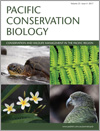
Pacific Conservation Biology
Volume 23 Number 4 2017
This is a review of ‘The Australian Bird Guide’ by Menkorst et al. (2017). It is also an essay that considers the impact of nomenclatural changes of Australian bird names on the communication of ornithological research and the conservation of birds.
PC17012The sharks and rays of the Solomon Islands: a synthesis of their biological diversity, values and conservation status
Sharks and rays are facing increasing anthropogenic pressure globally; however, data on their status and biodiversity are lacking for many Pacific Large Ocean Island States. This study aimed to construct a species checklist for the sharks and rays occurring in the Solomon Islands, review the human interactions with these species, and present a synthesis of their conservation status.
PC17012 Abstract | PC17012 Full Text | PC17012PDF (355 KB) | PC17012Supplementary Material (19 KB) Open Access Article
PC17017Utilising aversive conditioning to manage the behaviour of K’gari (Fraser Island) dingoes (Canis dingo)
Aversive conditioning offers a potential avenue to circumventing the lethal control of dingoes on K’gari (Fraser Island) otherwise deemed to represent an unacceptable risk to human safety. We reviewed the literature on aversive conditioning of predators and determined that certain measures relating to dingo exclusion, personal protection and remedial aversive conditioning could help to bolster the management of negative human-dingo interactions.
PC16028Changes in woodland bird communities as replanted woodland matures
It is important to understand the value of revegetation on farms for native bird species. The aim was to determine any changes in bird diversity and abundance in habitat plantings; over 10 years, bird communities in younger plantings converged with those in older plantings and remnant woodland. The results reaffirm that replanting native trees and shrubs on open farmland benefits woodland birds, and that many of the species benefitting are those of conservation concern in the temperate grassy woodlands.
PC17024Variation in bird assemblages and their invertebrate prey in eucalypt formations across a rainfall gradient in south-west Australia
Following a 25-year collaboration between entomologists and vertebrate ecologists, results have been brought together which indicate that avifauna abundance/diversity is influenced by invertebrate food resources at the landscape scale. Contrary to expectations, both invertebrate and bird abundance/diversity are higher in the lower rainfall Western Australian woodlands than in the moister jarrah forest. This may be associated with physiological adaptations of eucalypts to lower rainfall, which result in higher nitrogen levels per unit area of foliage, in turn favouring the build-up of an abundant arboreal invertebrate fauna.
PC17011Factors affecting frog species richness in the Solomon Islands
Studies across large oceanic archipelagos provide an opportunity for testing different processes driving patterns of species richness. This study used modelling to determine important ecological and biogeographic factors affecting the species richness of frogs at multiple locations on major islands across the Solomon Islands archipelago.
PC17016Implications of floristic patterns, and changes in stand structure following a large-scale, intense fire across forested ecosystems in south-western Australia
Four community groups differed in composition, species density, fire trait syndrome and structural responses 18 months after high-intensity fire near Northcliffe, south-western Australia. Height and biomass recovery takes longer than intense fire-return times requiring tall forest protection, and mosaic regimes to minimise impacts under warming and drying in the region.



